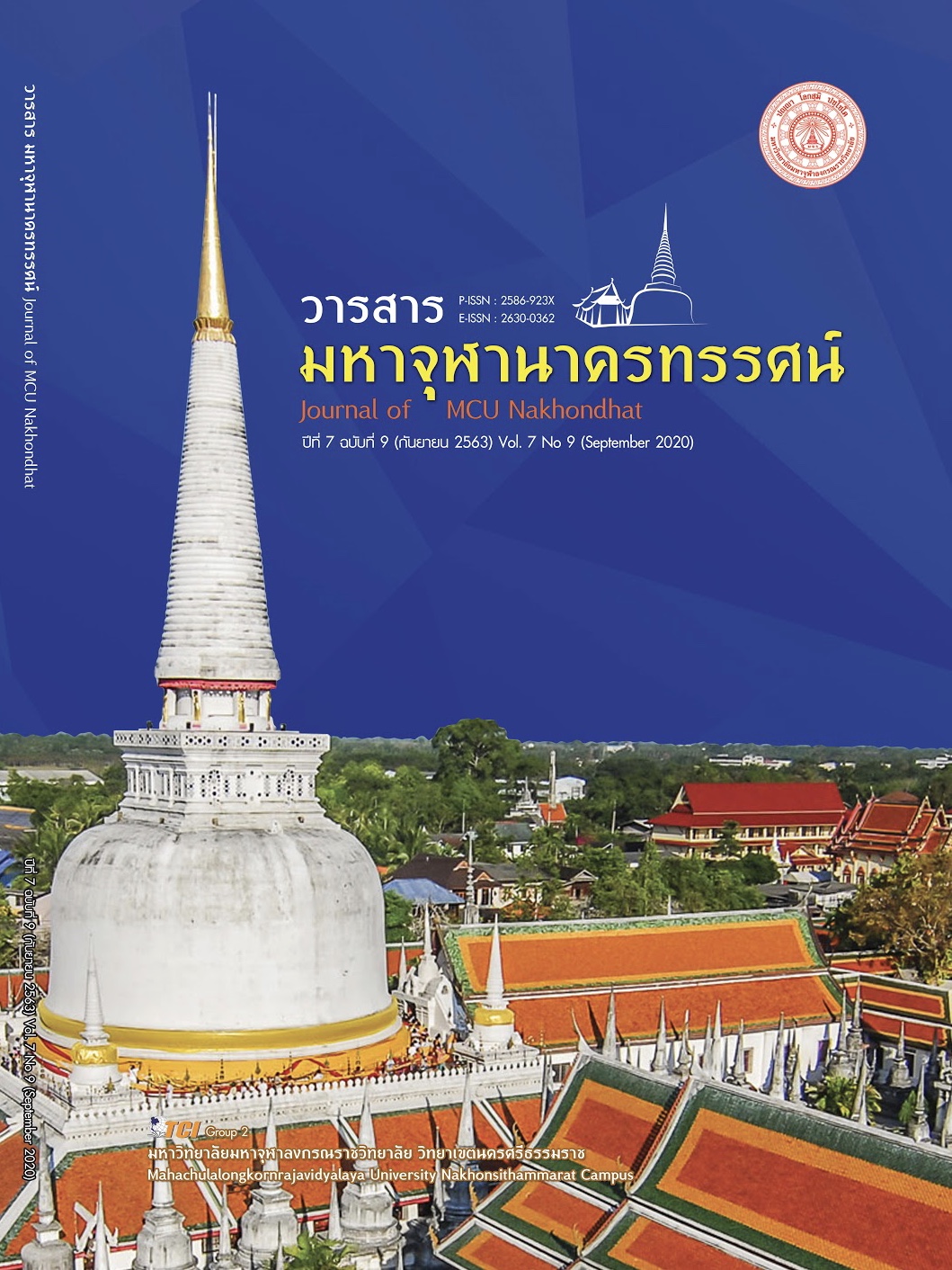EFFECTS OF USING PHONICS PRACTICAL BOOKS TO DEVELOP ENGLISH VOCABULARY LEARNING FOR PRIMARY II STUDENTS
Main Article Content
Abstract
The purposes of this research were to create efficiency of phonics practical books to be effective and to compare the achievement in English vocabulary learning before and after using phonics practical books for primary II students. The participants were 20 primary II students in second semester of 2019 academic year at Chumchonwatthasutharam School selected by simple random sampling. The duration of the experiment was eighteen hour that the students studied the six phonics practical books. The research instruments consisted of 1) phonics practical books for developing English vocabulary learning consisted of 6 phonics practical books with content validity index of 0.95 2) lesson plan for English vocabulary learning consisted of eighteen lesson plans with content validity index of 0.90 3) English vocabulary learning achievement test with reliability index of 0.87, discrimination index of 0.33, and difficulty index of 0.59 4) the criteria of English vocabulary learning achievement. The data were statistically analyzed by using mean, standard deviation, the efficiency of the phonics practical books, consistency index, discrimination, reliability and t-test for dependent. The results of the research showed that 1) the phonics practical books to developing English vocabulary learning for Primary II students by the researcher was at 84.29/82.50 2) achievement in English vocabulary learning before and after using the Phonics practical book for Primary II students were significantly higher than before learning at .05.
Article Details
References
ชัยยงค์ พรหมวงศ์. (2556). การทดสอบประสิทธิภาพสื่อหรือชุดการสอน. วารสารศิลปากรศึกษาศาสตร์วิจัย, 5(1), 7-20.
ณัฐพล สุริยมณฑล. (2561). การสอนแบบโฟนิกส์เพื่อส่งเสริมการออกเสียงและความรู้คำศัพท์ภาษาอังกฤษ ของนักเรียนชั้นประถมศึกษาปีที่ 1. วารสารมหาวิทยาลัยนครพนม, 8(2), 117-123.
ดวงใจ ตั้งสง่า. (2555). ชวนลูกเรียนภาษาอังกฤษ ตอน โฟนิกส์คืออะไร ทำไมต้องเรียน. เรียกใช้เมื่อ 15 สิงหาคม 2562 จาก http://taamkru.com/th/โฟนิคส์คืออะไร-ทำไมต้องเรียน/.
ทิศนา แขมมณี. (2551). ศาสตร์การสอนองค์ความรู้เพื่อการจัดกระบวนการเรียนรู้ที่มีประสิทธิภาพ. (พิมพ์ครั้งที่ 7). กรุงเทพมหานคร: สำนักพิมพ์แห่งจุฬาลงกรณ์มหาวิทยาลัย.
ประภาพร ถิ่นอ่อง. (2553). การพัฒนาแบบฝึกทักษะวิชาคณิตศาสตร์ เรื่อง การแยกตัวประกอบของพหุนามดีกรีสอง สาหรับนักเรียนชั้นมัธยมศึกษาปีที่ 3. ใน วิทยานิพนธ์การศึกษามหาบัณฑิต สาขาวิจัยและประเมินผลการศึกษา (วิจัยและพัฒนาการศึกษา). มหาวิทยาลัยนเรศวร.
ปัญจลักษณ์ ถวาย. (2556). การศึกษาผลสัมฤทธิ์และความคงทนในการจำคำสัพท์ภาษาอังกฤษของนักเรียนชั้นประถมศึกษาปีที่ 5 โรงเรียนสาธิตมหาวิทยาลัยราชภัฎบ้านสมเด็จเจ้าพระยาที่เรียนโดยใช้แบบฝึกกิจกรรมเพิ่มพูนคำศัพท์ร่วมกับการอ่าน. ใน วิทยานิพนธ์ศึกษาศาสตรมหาบัณฑิต สาขาวิชาการสอนภาษาอังกฤษในฐานะภาษาต่างประเทศ. มหาวิทยาลัยศิลปากร.
ปิยมาศ กิ่งน้ำฉา. (2559). การใช้วิธีการสอนแบบโฟนิกส์ผสมผสานกลวิธีช่วยจำ เพื่อพัฒนาผลสัมฤทธิ์และความคงทนในการจดจำคำศัพท์ภาษาอังกฤษของนักเรียนชั้นประถมศึกษาปีที่ 6. ใน วิทยานิพนธ์ครุศาสตร์มหาบัณฑิต สาขาการสอนภาษาอังกฤษเพื่อวิชาการและงานอาชีพ. มหาวิทยาลัยราชภัฏสุราษฎร์ธานี.
ลักษณพันธ์ บำรุงรัตนกุล. (2555). การพัฒนาการสะกดคำและออกเสียงภาษาอังกฤษของนักเรียนชั้นประถมศึกษาปีที่ 2 ของโรงเรียนสาธิตแห่งมหาวิทยาลัยเกษตรศาสตร์ด้วยวิธีการสอนแบบโฟนิกส์. ใน วิทยานิพนธ์ศิลปศาสตรมหาบัณฑิต สาขาวิชาภาษาอังกฤษเพื่อวิชาชีพ. มหาวิทยาลัยรังสิต.
ศิตา เยี่ยมขันติถาวร. (2557). เปลี่ยนมุมมองใหม่เพื่อพัฒนาภาษาอังกฤษเพื่อการสื่อสาร. วารสารปัญญาภิวัฒน์, 5(พิเศษ), 208-222.
สถาบันทดสอบทางการศึกษาแห่งชาติ (องค์การมหาชน). (2561). รายงานผลการทดสอบทางการศึกษาระดับชาติขั้นพื้นฐาน (O-NET) ชั้นประถมศึกษาปีที่ 6. เรียกใช้เมื่อ 14 กรกฎาคม 2562 จาก http//www.niets.or.th.
สุนันทา ปัญญารัตน์. (2554). การพัฒนาการสอนอ่านออกเสียงและเขียนสะกดคำภาษาอังกฤษด้วยวิธีการสอนแบบโฟนิกส์ ชั้นประถมศึกษาปีที่ 4 โรงเรียนลำสนุ่น อำเภอคลองหลวง จังหวัดปทุมธานี. ใน วิทยานิพนธ์ครุศาสตรมหาบัณฑิต สาขาวิชาเทคโนโลยีและสื่อสารการศึกษา. มหาวิทยาลัยราชภัฏพระนคร.
อำนวย เลื่อมใส. (2546). การสร้างหนังสือและแบบฝึกทักษะประกอบการเรียนภาษาไทย เรื่องผาน้าอ้อย แบบมุ่งประสบการณ์ภาษา ชั้นประถมศึกษาปีที่ 4. ใน วิทยานิพนธ์การศึกษามหาบัณฑิต สาขาวิชาหลักสูตรและการสอน. มหาวิทยาลัยมหาสารคาม.
Bock, S. (1993). Developing materials for the Study of Literature. English Teaching Forum, 31(63), 2-4.
Fitzgerald, J.A. & Fitzgerald, P.G. (1967). Fundamental of Reading Instruction. America: The Bruce.
Grant, M. (2014). Longitudinal Study from Reception to Year 2: The Effects of a Systematic Synthetic Phonics Program on Reading, Writing and Spelling Reading Reform Foundation. Retrieved July 12, 2019, from https://www.google.com/urlsa=t&rct=j&q=&esrc=s&source=web&cd=&cad=rja&uact=8&ved=2ahUKEwipiMW16YjrAhUGA3IKHRCsA6oQFjAAegQIBBAB&url=http%3A%2F%2Fwww.rrf.org.uk%2Fpdf%2FGrant%2520Follow-Up%2520Studies%2520-%2520May% 25202014.pdf&usg= AOvVaw2kc Pq0UbREvjJkWJys
Jones, S. A. & Deterding, D. (2007). Phonics and beginning reading: a practical guide for teachers in Southeast Asia. Singapore: McGraw-Hill Education (Asia).
Krashen, S. D. (1987). Principles and Practice in Second Language Acquisition. New York: Prentice Hall.
Lapp, D. & Flood, J. (1992). Teaching reading to language. New York: Macmillan.
NIH/National Institute Of Child Health And Human Development. (2004). Imaging Study Reveals Brain Function Of Poor Readers Can Improve. Retrieved July 12, 2019, from www.sciencedaily.com/releases/ 2004/04 / 040420011157.htm


